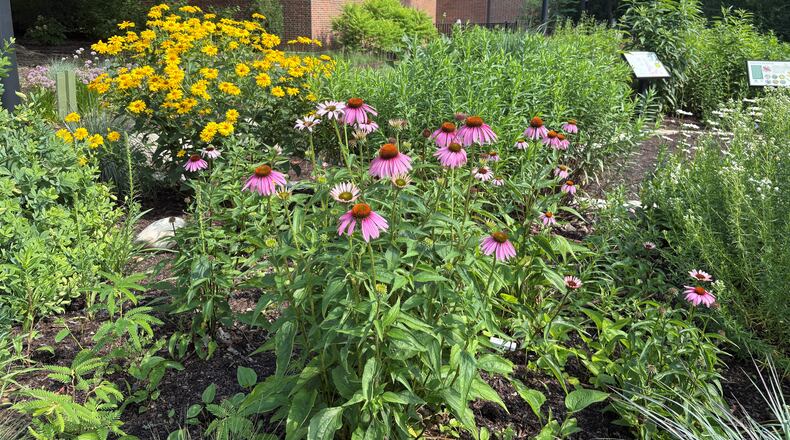The gardens change every day and from season to season to feed the early pollinators through to the late fall.
The library gained national attention recently from the American Library Association for its efforts, which started with the 2021 library renovation project and community read of the book “Nature’s Best Hope” by author Douglas Tallamy that outlines a grassroots approach to conservation, building wildlife corridors made up of people’s yards.
“I realized that because native plants are a little bit of a different aesthetic, I wanted to start with education first,” said Elizabeth Schmidt, the library’s adult services coordinator.
Through grants and partnerships the library organized events surrounding “Nature’s Best Hope,” including a book discussion as well as an author presentation with 150 online participants, all before the garden was planted.
“We had a huge response to that,” she said.
Credit: Jen Balduf
Credit: Jen Balduf
The first garden planted is a sun garden with native plants that support pollinators, including purple coneflower, cardinal flower, black-eyed Susan, blazing stars, New England aster, Joe-Pye weed, wild bergamot and goldenrod.
Typically, native plant gardens take a few years to fully establish, following the adage of sleep, creep and leap, said Maura Boesch of Kettering, a master gardener and volunteer who helps care for the library gardens.
“Once established, they don’t take much water,” said Boesch, who added they take less maintenance and do not need fertilizer.
The library has added a shade garden and a third sun garden when landscaping needed replacement. In addition to volunteers, Green Oakwood and Dayton area Wild Ones also helped to make the gardens a reality, Schmidt said.
Education about native gardens included the city of Oakwood, which had outlawed one native plant, ironwood, as a weed. The law was changed in 2022 in the city, which now has a native plant guide on its website.
The library won a city of Oakwood beautification award in 2023 and also is a National Wildlife Federation certified wildlife habitat.
Obstacles in many communities is the aesthetics of a native plant garden, which can be perceived as messy or weeds.
“It does need to be maintained, intentional, have borders,” said Oakwood resident Cheryl Vargas, an Ohio certified volunteer naturalist and volunteer who helps maintain the library gardens.
The library is continuing its educational outreach on native plants with a native plant garden tour and talk from 6 to 7 p.m. Thursday, where participants can hear from native plant experts who helped develop and maintain the sun and shade gardens. After the talk, people can walk to a nearby native plant garden.
Credit: Jen Balduf
Credit: Jen Balduf
The gardens have inspired and educated others to create their own home gardens, as well as native plant gardens at Smith and Harmon elementary schools in Oakwood.
“What we’re doing matters,” Vargas said.
What the library is doing is not only recognized at home.
“We’ve been contacted by libraries in other states to find out how we got started,” said Library Director Kristi Hale.
About the Author


